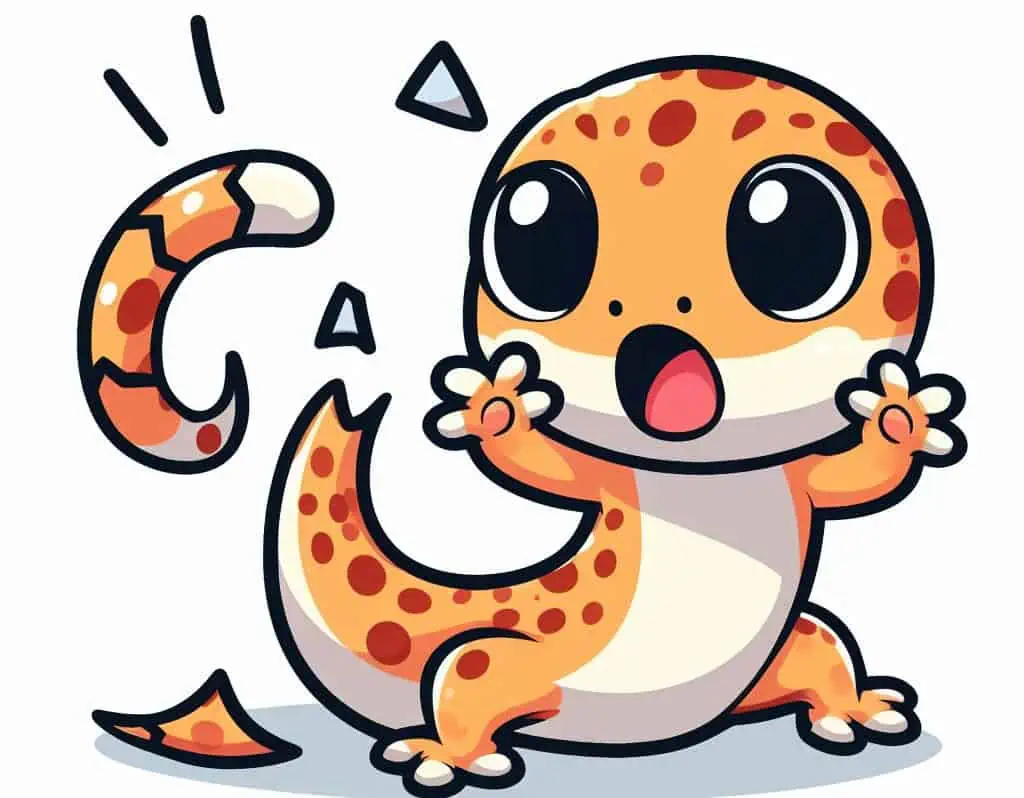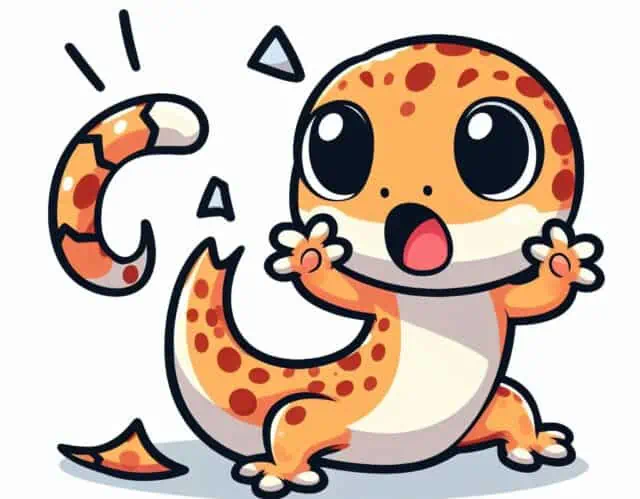Leopard gecko tail drop is a defense mechanism where the gecko voluntarily sheds its tail to escape from predators or cope with stress. The tail detaches quickly, often distracting the threat long enough for the gecko to flee to safety. This phenomenon involves complex biological processes, and understanding it is essential for proper care.
Tail Drop Mechanism: Leopard geckos can drop their tails as a defense mechanism when they feel threatened. The tail serves to distract predators, allowing the gecko to escape.
Stress Factors: Stress from environmental conditions like extreme humidity or temperature can cause tail drop. Ideal humidity for healing is around 40-50%.
Treatment Steps: After a tail drop, gently clean the tail stump with clean water and apply a thin layer of antibiotic ointment to prevent infection.
Recovery Time: The healing process typically takes 3-4 weeks. During this time, maintain a stress-free environment to expedite healing.
What is the Leopard Gecko Tail Drop?
Tail drop in leopard geckos is a natural survival tactic. The gecko has the ability to drop its tail as a defense mechanism. When the tail drops, a process known as autotomy, it continues to twitch. This twitching confuses or distracts predators, giving the gecko time to escape. The mechanism involves the contraction of muscles and the breaking of weak points in the tailbone.
What are the Causes of Tail Drop in Leopard Geckos?
Understanding the causes of tail drop in leopard geckos is key to preventing it. Various factors can trigger this event, ranging from natural defense responses to environmental conditions.
Response to Threats
Leopard geckos have developed unique ways to deal with response to threats. One such way is through tail drop, which acts as a defense mechanism. When feeling threatened, a leopard gecko might drop its tail as a last resort. The tail doesn’t just fall off; it actively twitches and moves. This tail movement captures the attention of the predator, allowing the gecko to escape.
But what if you have multiple leopard geckos? When one gecko drops its tail, it can stress others in the enclosure. It’s vital to separate potential victims from the group to prevent a chain reaction of tail drops. Separating them limits stress and prevents more tails from falling off.
Stuck Tail
A common issue that can lead to tail drop is a stuck tail. The architecture of the gecko’s enclosure plays a significant role in this. Tight corners and potential falling objects in the enclosure can cause the gecko’s tail to get trapped. It’s crucial to design the habitat in a way that minimizes these risks. Avoiding tight spaces and unstable items will go a long way in keeping your gecko safe.
To prevent a stuck tail, it’s not just about the initial setup; ongoing maintenance is key. Regularly inspect the enclosure for any new hazards that may have been overlooked. Double-check corners, crevices, and above-ground spaces for anything that could trap a tail. Make it a routine to ensure that the environment remains as risk-free as possible.
Stress and Fear
In leopard geckos, stress and fear are major culprits behind tail dropping. Emotional distress activates the gecko’s survival instinct, sometimes causing them to shed their tails as a last-ditch effort to evade perceived threats. Understanding the emotional well-being of your leopard gecko is crucial for preventing unnecessary tail loss.
Environmental conditions play a big part in inducing stress. Extreme humidity, temperature fluctuations, bright lights, and loud noises can all elevate a gecko’s stress levels. When these factors are present, the likelihood of tail drop increases. It’s not just about physical hazards; the gecko’s emotional environment matters too.
Managing these stressors is vital. Keep an eye on temperature and humidity levels, making sure they are within the recommended ranges. Dim the lights during the gecko’s rest periods and keep the noise level down.
Illness and Infection
In leopard geckos, illnesses and infections are another serious cause of tail drop. When a gecko is sick, its body undergoes extreme stress. This heightened stress can provoke tail loss as a physiological response to the internal upheaval.
Various kinds of illnesses can contribute to this problem. Some directly affect the tail area, like fungal or bacterial infections localized to the tail. These infections compromise the tail’s health, making it more likely to drop.
On the other hand, some illnesses indirectly lead to tail drop as a stress-related symptom. For example, respiratory or digestive issues may not directly involve the tail, but the overall stress and discomfort can push the gecko to drop its tail.
Signs and Symptoms of Tail Drop in Leopard Geckos
One of the key aspects of dealing with tail drop in leopard geckos is knowing the signs and symptoms to look for. Physical indications are the most obvious, but behavioral changes can also signal an issue.
A dropped tail can either be partial or full. A partially dropped tail will show signs of scarring or uneven texture. It won’t look as smooth as the rest of the tail. A fully dropped tail is more evident, as the tail will be much shorter and a stub may appear where the tail used to be.
Behavioral changes can include reduced movement, reluctance to eat, or signs of distress like excessive hiding. These behaviors indicate that the gecko is in discomfort and may have suffered from tail loss.
To assess the severity, look for both physical and behavioral indicators. An abrupt change in both is a red flag.
Treatment of Leopard Gecko Tail Drop
Tail drop in leopard geckos can be a serious issue that requires immediate attention. Knowing the right treatment steps to take is crucial for your pet’s recovery.
Antibiotic Ointment Application
The first step in treating a dropped tail is to clean the tail stump. Use a cotton bud and clean water to gently remove debris and bacteria. This preps the area for antibiotic ointment.
Next, apply a thin layer of antibiotic ointment to the stump. This helps to prevent infection, which is crucial for a smooth healing process.
Finally, keep an eye on the tail stump during healing. Look for signs of infection or other complications. Immediate action can make a big difference in recovery time.
Loose Substrate Removal
Loose substrate in the vivarium can be a problem. It can stress the gecko and cause more damage to the tail. Gravel and sand are common culprits.
To remove loose substrate, first take the gecko out of the enclosure. Then scoop out the gravel or sand. Replace it with something less risky, like paper towels. These are easier to clean and don’t pose a threat to the tail.
Paper Towel Substrate Change
Switching to a paper towel substrate is a smart move for your leopard gecko enclosure. First, you’ll need to remove the old substrate. Use gloves and take out all gravel, sand, or other materials. Make sure the enclosure is empty and clean.
Next, lay down clean paper towels. Smooth out any wrinkles. They should cover the entire bottom of the leopard gecko enclosure. This provides a safe and hygienic environment for the gecko, reducing stress and risks associated with loose or contaminated substrates.
The Recovery Process
Managing the recovery of a leopard gecko after tail drop is crucial. Proper care and timely actions can speed up healing and minimize complications.
Maintaining the right humidity levels is crucial during the healing process of a leopard gecko’s tail drop. Normally, these reptiles thrive in a dry environment with low humidity.
However, when they’re recovering from tail drop, a slightly more humid setting is beneficial. Keeping the humidity level around 40-50% can help with healing and the regrowth process. Monitor these levels carefully to ensure optimal conditions for recovery.
3-4 Weeks of Recovery Timeframe
The timeframe for a leopard gecko’s recovery from tail drop is generally 3-4 weeks. During this period, the tail stump begins to heal and may even show signs of regrowth. This duration is not a rigid standard but serves as a general guideline based on observations and veterinary advice.
Creating a stress-free environment is key to expediting this healing process. Any form of stress can hinder recovery, potentially leading to more severe health issues. Therefore, it’s essential to minimize disturbances and make the gecko as comfortable as possible. This includes controlling temperature and humidity, as well as limiting loud noises and sudden movements in the gecko’s vicinity.
Monitoring the healing process closely during these 3-4 weeks is also crucial. Regular checks can help you spot any signs of infection or other complications early. Keeping an eye out for these signs can help you take timely action, such as administering antibiotic ointment or seeking veterinary advice, to ensure that the recovery stays on track.
In general, it’s a good idea to observe the leo’s behavior to spot any issues, whether it’s weight loss or a shedding problem, to mention just two.






